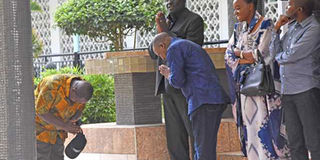Covid-19 outbreak: World struggles to stop the handshake

Interior CS Fred Matiang’i (left) and Health CS Mutahi Kagwe greet each other before the press briefing at Harambee House on Sunday. PHOTO | FILE | NATION MEDIA GROUP
What you need to know:
- WHO Director-General Tedros Adhanom Ghebreyesus announced that he preferred placing his hand on his heart when greeting people.
- Shaking hands transmits two times more bacteria than high fives, and 10 times more than bumping fists, a study in the August 2014 issue of the American Journal of Infection Control says.
Thanks to the coronavirus outbreak, you no longer have to worry about what your handshake says about you.
Whether your grip is too firm, too limp, too rushed or just right, it doesn’t matter anymore — the world is relinquishing shaking hands.
As the new coronavirus gradually spread around the world, the World Health Organization (WHO) released basic guidelines on how people could keep it at bay. One of the recommendations was refraining from shaking hands.
BUMPING ELBOWS
WHO Director-General Tedros Adhanom Ghebreyesus announced that he preferred placing his hand on his heart when greeting people. He said that an elbow bump, which many had adopted in place of the handshake, would not do since it puts you within a metre of the other person, which is too close for these times.
It seems, though, that Prince Harry missed the memo, after he was filmed bumping elbows with British singer-songwriter Craig David at a recent Commonwealth Day ceremony at Westminster Abbey.
Democratic US presidential candidates Joe Biden and Senator Bernie Sanders also did it the wrong way when they bumped elbows just before the start of the debate held in CNN’s studios on March 15.
Notably, the debate had no audience — WHO and other global health organisations have advised against congregating.
But the worst offender has to be US President Donald Trump. He shook hands freely with business executives, who appeared alongside him at a coronavirus news conference last Friday.
When President Kenyatta arrived at Harambee House on Sunday to announce the steps being taken to curb the spread of the virus, he and government officials at the press conference opted for the customary Hindu greeting, namaste. It involves pressing one’s hands together and bowing slightly.
HANDHSHAKE
French President Emmanuel Macron, also took this option when he met Spain’s king and queen last week.
But old habits die hard, and while people adopt new forms of greeting, many are forgetting and finding themselves stretching their hand for a handshake.
Take Diana Kimanthi for instance. On Tuesday, she went to her son’s school following the directive to close all schools. When she got there and stretched her hand to shake the teacher’s hand, the response was a reluctant clasp.
Ms Kimanthi, who realised her mistake much later says: “We’ve been shaking hands since we were born. It’s difficult to unlearn this overnight.”
The handshake is a big deal around here, the most famous one being the one between President Kenyatta and ODM leader Raila Odinga. So the struggle is understandable.
This is not the first time, however, that there is a call to drop the handshake. Some medics have referred to it as a modern-day health hazard.
Shaking hands transmits two times more bacteria than high fives, and 10 times more than bumping fists, a study in the August 2014 issue of the American Journal of Infection Control says.
With this in mind, isn’t it about time the world simply did away with the handshake and looked for contactless ways to convey goodwill?





